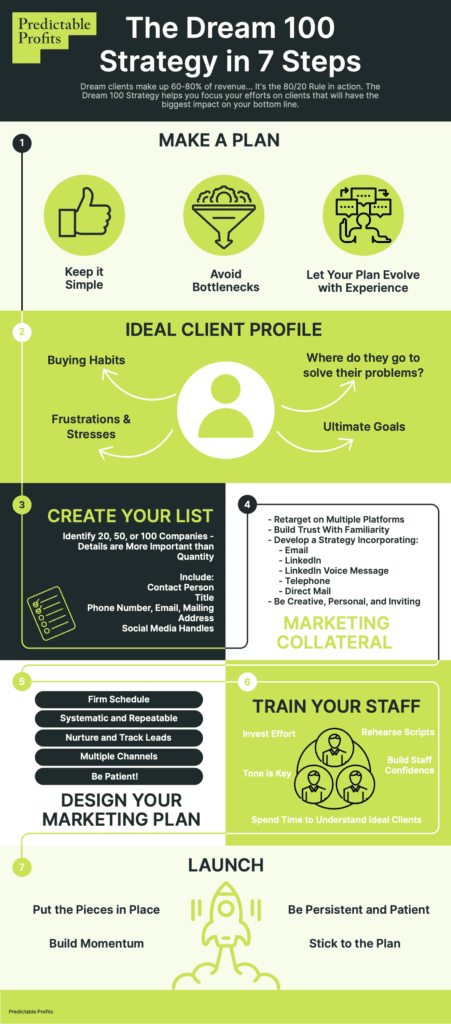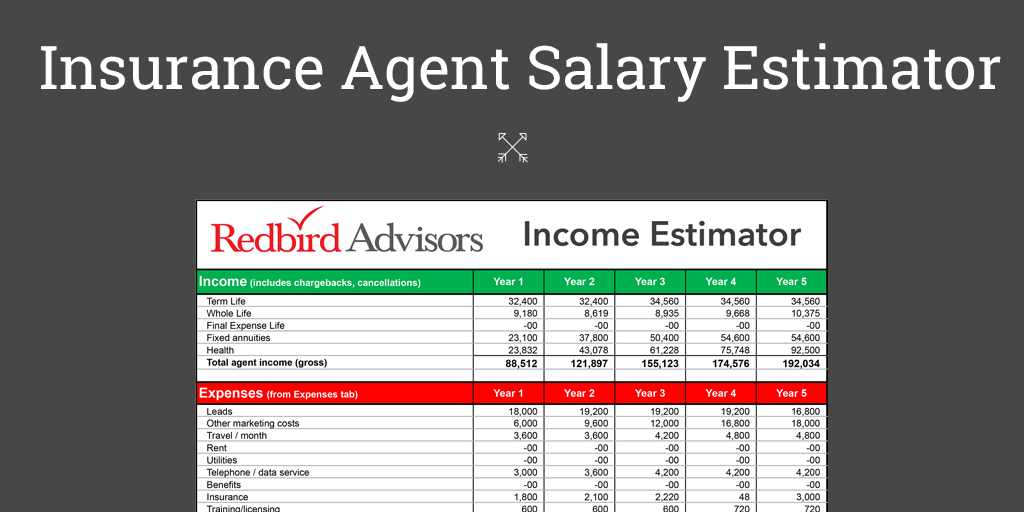
To understand The Dream 100 Strategy, you first have to understand that there are two types of ideal clients:
- Great clients
- Dream clients
You’ll always have many more “great clients” than “dream clients” – but the dream clients will make up 60%–80% of your revenue. It’s the 80/20 rule in action: “80% of your results come from only 20% of your clients.”
The Dream 100 Sales Strategy (originated by the late Chet Holmes) is a balance of attracting both great and dream clients.
How The Dream 100 Strategy Got Started
Chet Holmes worked for Charlie Munger, one of the most celebrated investors in the world. He was a salesman at Munger’s company, where he had to make a hundred calls per day. However, he wasn’t happy with the results.
He noticed that the top salesperson in the company was a woman making three times as many sales as the runner-up. Wanting to learn her secret, he repeatedly asked her for help.
One day, the woman finally gave in and took him to lunch.
She explained that her secret involved only focusing on ideal clients.
With this new knowledge, Holmes went through his list of 2,200 leads and chose 167 of the most promising to focus on.
Fast forward six months… And Holmes didn’t close a single deal.
Surprised?
Munger thought so as well. When he reached out to Holmes to find out what was wrong, Holmes asked for Munger’s trust.
Five minutes later, Holmes closed the first deal. And in the next six months, he closed 11 more, including some of the largest orders in the company’s history.
Chet Holmes says:
The goal of the Dream 100 is to take your ideal buyers from “I’ve never heard of this company” to “What is this company I keep hearing about?” to “I think I’ve heard of that company” to “Yes, I’ve heard of that company” to “Yes, I do business with that company.”
Holmes went on to develop The Dream 100 Sales Strategy, a more affordable and effective way to land dream clients. The strategy consists of seven essential steps…
Step 1: Develop a Strategic Plan for Your Dream 100
With a clear framework present, you need a strategic approach for finding your ideal clients.
The key here isn’t to come up with a complex processes for the strategy. In fact, the very opposite is true.
You need to keep things simple and straightforward to avoid bottlenecks and confusion.
Of course, a strategic plan isn’t a document that you create once and file away somewhere. It’s got to be a live document that your team will be working from. That’s part of the reason for making the plan simple and easy to understand for all.
You can use a range of software tools to develop your strategic plan. Alternatively, you can go old school and use pen and paper. It really doesn’t matter how you approach it, so long as you have a plan.
Step 2: Determine Your Dream 100 Client Profile

As they work on defining their ideal clients, the downfall for many business owners is an over-reliance on the broadest categories like revenue, title of the decision maker, etc.
While that’s important, when it comes to your Dream 100 clients, the more relevant, targeted, and personal your message – the higher the conversion rate.
Take into consideration the finest details of your ideal client’s life…
- What are their buying habits?
- What frustrations and stresses keep them up at night?
- Where do they go to solve their problems?
- What are the ultimate goals they set for themselves?
These are only some of the questions you must answer when developing your Dream 100 best client profile.
Of course, you should also focus on how your company can uniquely benefit them…
Go through your top clients and find out what characteristics make them ideal. For most companies, 20% of the clients at the top contribute 80% of the revenue.
What attracts such clients to your company?
What other Dream 100 targets can you identify that would dramatically move the needle in your business?
Going forward, you’re going to focus on all of the things that make you want to work with these clients. It could be their story, persona, or even geographical location.
The point is, you should explore as much detail as possible while coming up with your best client profile.
Step 3: Create Your Dream 100 List

Having determined your best client profile, it’s time to make your Dream 100 list. This list should contain all the clients that fit your criteria.
As Chet Holmes says:
“If there were 100 clients that, if you’ve got them all, you could dramatically increase your business…”
Depending on the size of your market, you may not hit 100 companies that you want to work with… But the list can easily just have 20, 50, or however many businesses that meet the criteria. The number doesn’t matter nearly as much as the details attached to each.
This means that you’re going to have to use due diligence in defining those clients. On top of naming the your ideal clients, you’re going to need information like:
- Contact person
- Title
- Phone number, email, mailing address
- Social media handles (like LinkedIn and Twitter)
Also, try your best to gather as many other relevant details as you can, such as looking at professional bios to see what awards/recognitions a company or leader has earned, recent articles mentions, books published, etc.
Doing so will inform you about who you’ll be talking to.
Get to know your ideal clients, and you’ll have a much higher chance of closing the deal.
Step 4: Design Your Dream 100 Marketing Collateral

The fact is that only 3% of your sellable market is ready to buy right now…
Because of this, you want a strategy that puts you on their radar, allows you to stay top of mind, and preemptively positions you as the obvious choice the moment they find themselves ready to buy what you have to offer.
For Dream 100 Strategies, this begins with your Dream 100 client becoming familiar with who you are…
To start, you want to retarget the entire list of Dream 100 clients (and those in the company that influence decisions) on platforms such as Adroll, Facebook, Google Display Network, and LinkedIn. The goal is to get them to say: “I see this company everywhere!”
Familiarity breeds trust.
Then you want to reach out to them using an omni-channel approach…
We work with our business coaching clients to develop a strategy that includes:
- LinkedIn Voice Message
- Telephone
- Direct Mail
But we’re not talking about a “one-size fits all” approach like many outbound prospecting sales strategies.
For a Dream 100 client, you’ve got to do your research with an eye on making your marketing more creative, personal, and inviting.
Step 5: Design Your Dream 100 Marketing Plan
Once you’ve defined your marketing collateral, it’s time to plan ahead. This means creating a firm marketing schedule for staying top of mind.
In addition, your marketing implementation should be systematic and repeatable. The easiest way to make this happen is to create a marketing calendar and fill it with all your activities.
In the first month, for example, you could plan on pre-heating the list with retargeting and engaging with them (like/commenting) on LinkedIn. The next month, perhaps using email, make a LinkedIn connection and a phone call. Whatever your marketing collateral is, spread it throughout the calendar and execute accordingly.
Make sure you create a lead list inside of LinkedIn Sales Navigator. Several times a week, like and comment on their posts. This an additional way to stay in front of them while, and at the same time, give them something they want (i.e., engagement).
Remember, this is a long term strategy – you’re not going into this with the idea that you’ll get the results of your Dream 100 Strategy right away. But as the saying goes: patience pays off.
Step 6: Train Your Sales Staff on The Dream 100 Strategy
According to a survey, words account for only 7% of communication. The rest isn’t about what you say, but how you say it…
A big mistake that many companies make is not putting enough effort into training. If your staff isn’t fully prepared to handle your ideal clients, so much of your marketing efforts will go to waste.
Because of this, your sales staff should rehearse their scripts until they’re 100% confident in their skills. Even a slight change in tone (or hint that there’s a “pitch” coming) can have an outsized impact.
Remember, Dream 100 clients aren’t a one-size fits all situation… This strategy requires a deep understanding of the client and why working with you is the best decision that they could make for their business.
Step 7: Launch Your Dream 100
If you’ve executed the first six steps properly, this one should be as easy as it gets. With a tight marketing plan in place, you’re going to execute it for months to come.
In the first six months or so, you’re building the momentum. Persistence and patience are paramount here. So many businesses gave up just before their marketing starts working.
Believe in your strategy and stay faithful to the plan.

Going Long
The Dream 100 Strategy isn’t for those who are looking for instant gratification. It’s for serious business leaders who are looking to achieve great things in the long run.
As you can see, there’s nothing complicated about the strategy. Time, effort, and attention to detail are all you’re going to need.
When defining your ideal client profile, be thorough and gather as much information as you can.
This will allow you to tailor your marketing strategy to the most ideal clients. All that’s left after that is perseverance – and to keep working at it.
CHARLES GAUDET


